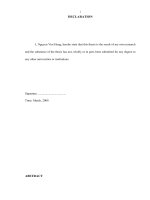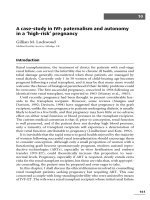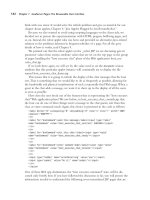Port governance: A general research and case study in Vietnam
Bạn đang xem bản rút gọn của tài liệu. Xem và tải ngay bản đầy đủ của tài liệu tại đây (905.26 KB, 9 trang )
PORT GOVERNANCE:
A GENERAL RESEARCH AND CASE STUDY IN VIETNAM
Hoang Thi Lich
Vietnam Maritime University
Email:
Ngày nhận bài: 04/3/2019
Ngày PB đánh giá: 17/4/2019
Ngày duyệt đăng: 19/4/2019
ABSTRACT
This paper covers two main parts. In the first one, the author focuses on investigating and
reviewing the main issues of port governance in the world from previous studies in different
famous journals. The results show that in most research about port governance, the authors
focus much on the definition, the purpose or the role of port governance, the governance
structure, the governance model, the port ownership, legal documents and port policies related
to ports. Then the second part of this paper presents the author’s application of the theoretical
background from the first part into the current situation of Vietnamese port governance and
her suggested solutions to improve port governance in Vietnam in the future.
Key words: Port governance, port governance model, port ownership, port governance
structure, port policies, port governance in Vietnam
QUẢN TRỊ CẢNG BIỂN:
NGHIÊN CỨU TỔNG QUAN VÀ THỰC TIỄN Ở VIỆT NAM
TÓM TẮT
Bài báo sẽ tập trung vào hai phần chính. Phần thứ nhất, tác giả sẽ tập trung nghiên cứu
và hệ thống lại các vấn đề chính liên quan đến Quản trị cảng biển (Port Governance) trên
thế giới từ các bài báo khác nhau trong các tạp chí nổi tiếng khác nhau. Kết quả nghiên
cứu cho thấy hầu hết các nghiên cứu về Port Governance đều tập trung vào các khái
niệm, mục đích hoặc vai trò, cấu trúc, mô hình, sở hữu cảng biển của Port Governance,
các văn bản pháp lý và chính sách cảng biển. Qua đó, trong phần hai, tác giả sẽ áp dụng
vào thực tiễn thực trạng Port Governance tại Việt Nam. Đồng thời tác giả sẽ đưa ra một
số đề xuất nhằm hoàn thiện Port Governance tại Việt Nam trong thời gian tới.
Từ khoá: Quản trị cảng biển, mô hình quản trị cảng biển, sở hữu cảng biển, cấu trúc
quản trị cảng biển, chính sách cảng biển, quản trị cảng biển tại Việt Nam
1. INTRODUCTION
Seaport is the gateway of a any country.
Seaport is a focal point, an important node
in a country’s transport system. Sea ports
increasingly play an important role in the
socio-economic development of a country.
The volume of imports and exports between
countries in the region and the world today
is mainly through the way of sea transport.
Due to the different geographical positions
and distance to markets, the linkage,
cooperation between countries and the
involvement in the supply chain system,
the role of seaports depend greatly on port
Port Governance, seaport competition, port
operation and institutional reforms of port.
On the other hand, with increasing port costs,
the integration between trade and economic
inefficiencies leads to the declining
competitiveness of seaports and inefficient
port operation. Many studies have shown
that the main reason is due to inappropriate
port management and management model,
weak competitiveness, large gap between
port governance and legal framework and
a series of issues. Other issues related to
procedures and administrative procedures
in the seaport sector. Therefore, the study
of seaport governance is very necessary in
the context of globalization and the trend
of commercialization, internationalization
and privatization worldwide which is taking
place. Seaports are under the influence of
these trends. The study of seaport governance
is the generalization of concepts, contents
and especially issues related to seaport
governance through systematizing previous
studies and applying them in practice in
Vietnam. After that, the author will find out
the limitations and finding solutions or giving
some suggestions to improve the efficiency
of seaport management and operations
activities in the future, contributin����������������������������������������������������������������������������������������������������������������������������������������������������������������������������������������������������������������������������������������������������������������������������������������������������������������������������������������������������������������������������������������������������������������������������������������������������������������������������������������������������������������������������������������������������������������������������������������������������������������������������������������������������������������������������������������������������������������������������������������������������������������������������������������������������������������������������������������������������������������������������������������������������������������������������������������������������������������������������������������������������������������������������������������������������������������������������������������������������������������������������������������������������������������������������������������������������������������������������������������������������������������������������������������������������������������������������������������������������������������������������������������������������������������������������������������������������������������������������������������������������������������������������������������������������������������������������������������������������������������������������������������������������������������������������������������������������������������������������������������������������������������������������������������������������������������������������������������������������������������������������������������������������������������������������������������������������������������������������������������������������������������������������������������������������������������������������������������������������������������������������������������������������������������������������������������������������������������������������������������������������������������������������������������������������������������������������������������������������������������������������������������������������������������������������������������������������������������������������������������������������������������������������������������������������������������������������������������������������������������������������������������������������������������������������������������������������������������������������������������������������������������������������������������������������������������������������������������������������������������������������������������������������������������������������������������������������������������������������������������������������������������������������������������������������������������������������������������������������������������������������������������������������������������������������������������������������������������������������������������������������������������������������������������������������������������������������������������������������������������������������������������������������������������������������������������������������������������������������������������������������������������������������������������������������������������������������������������������������������������������������������������������������������������������������������������������������������������������������������������������������������������������������������������������������������������������������������������������������������������������������������������������������������������������������������������������������������������������������������������������������������������������������������������������������������������������������������������������������������������������������������������������������������������������������������������������������������������������������������������������������������������gure 2. Structure of Port Governance
Source: Adolf K. Y. Ng
According to Geiger (2011), cited
in Borges Vieira et al. (2014), any port
governance model will consider and answer
3 questions, what is seaport governance,
how the port is governed and how to
manage seaports. There are three views
directly related to port administration: port
governance structure, administrative actions
and port administration elements.
Port structure (Figure 2) refers to
the legal framework, action is the tool to
achieve cohesion in seaports, the elements
TẠP CHÍ KHOA HỌC, Số 34, tháng 05 năm 2019
15
of port administration are the agents and
that: Seaport management involves port
relationships with each other.
ownership, port management and port
Within the legal framework of
seaport governance, Tall (2009) points out
operation control.
Field of port governance
Figure 3. The basic governing actors and governed objects in port governance
Source: G. Zhang et al. 2018
What will Port Governance govern?
As we know, government organizations
are organizations that focus on issuing
legal documents and regulations related
to seaports. Meanwhile, the main function
of ports is to manage and exploit the port.
Government and seaport organizations will
create a major port authority. Therefore, the
main objective of Port Governance and in
a logical and logical way is divided into 2
categories. This also implies the relationship
between seaport management agents and
governance objectives expressed in the port
administration structure or model or port
administration tool.
3. PORT GOVERNANCE IN VIETNAM
3.1 Overview of seaport in Vietnam
Port plays an important part in
Vietnam’s trade and economy. Globalization
and integration has driven challenges to
16
TRƯỜNG ĐẠI HỌC HẢI PHÒNG
Vietnamese seaport system. Port governance
is one of the biggest issues nowadays in
Vietnam. This article looks at the current
status of port, port governance structure and
as well as port ownership of Vietnamese
port and changes in national policies on
port industry regulated by the Vietnamese
government… ect. Literature review shows
the port studies have officially focused on
port governance and how port governance
will become a part of port devolution in
the world. The author will discuss and
analyze the port governance in Vietnam to
investigate the solutions to enhance the port
governance in Vietnam in the future.
Vietnam has a long coastline of more than
3260 km, located in an important geopolitical
position, 3 sides adjacent to the East Sea, with
the Maritime Index 0.01. Currently there are
28 out of 64 provinces and cities in Vietnam
with sea. Vietnam is located in the region with
the busiest sea traffic in the world. Most of the
world’s major seaports are located in Asia, the
world’s main shipping routes all pass through
this sea area. with the favorable geographical
position, it can be one of the driving forces for
seaport development, developing Vietnam’s
maritime economy in the future.
Vietnam currently has totally 44
seaports (17 seaports of type I and IA, 14
seaports of type II, 13 seaports of type III,
and offshore oil ports (Decision No. 2013,
2013), divided into 6 groups of seaports
stretching from north to south:
- Group 1: In the North from Quang
Ninh to Ninh Binh provinces;
- Group 2: In the North Central Coast
from Thanh Hoa to Ha Tinh provinces;
- Group 3: In the Central Coast from
Quang Binh to Quang Ngai provinces;
- Group 4: In the South Central Coast
from Binh Dinh to Binh Thuan provinces;
- Group 5: In the southeast of Ho Chi
Minh City;
- Group 6: In the Mekong Delta River
(including Phu Quoc Island and islands in
the southwest);
Table 2. Characteristics of 6 seaport groups in Vietnam
Seaport
Group
Group 1
Group 2
Group 3
Group 4
Group 5
Group 6
Ship DWT
Total Length (m)
( Max)
53.000
12.920
82.295
2.672
45.000
5.790
50.000
5.494
160.000
29.422
20.000
3.035
Total Capacity
Ton
62.595.000
135.900.000
33.978.000
39.365.000
84.412.375
15.815.508
Teu
2.231.000
290.000
11.485.000
16.000
Source: Vietnam Maritime Administration
3.2 Growth of cargo throughput through
seaport system in Vietnam
In the period of 12 years, the total cargo
throughput in Hai Phong port, Ho Chi Minh
Port and in Vietnam seaport system climbed
up dramatically. Hai Phong port witnessed
the increase from 13.5 million tons in 2005 to
78.13 million tons in 2016. The annual average
growth was about 14%. Whereas, Ho Chi
Minh port, the biggest port in Vietnam, the total
cargo throughput increased from 71 million
tons to 111 million tons in 2016. However, the
total volume of cargo declined to 80.7 million
tons and 79.2 million tons in 2010 and 2011
respectively before it rose again in the next
years. The total cargo volume through Ho Chi
Minh reached at the peak of 111 million tons
in 2016. Finally, the total cargo through put in
the seaport system in Vietnam increased stably
from 140 million tons to 459 million tons in
the 12-year period with the average growth of
approximately 20% annually. (see Figure 4)
TẠP CHÍ KHOA HỌC, Số 34, tháng 05 năm 2019
17
500
400
300
200
100
0
2005 2006 2007 2008 2009 2010 2011 2012 2013 2014 2015 2016
Hai Phong Port
Ho Chi Minh Port
Viet Nam port
Figure 4. Cargo throughput from 2005 to 2016 in Hai Phong, Ho Chi Minh and Vietnam seaport
Source: Compiled from Vietnam Maritime Administration
3.3. Port Ownership and management
Vietnamese seaports are now owned
and managed by various ministries and
agencies: Ministry of Transport (most major
seaports in Vietnam), Ministry of Industry
and Trade (Cam Pha coal port), Ministry of
Commerce, Ministry of Defense. Vietnam
National Shipping Lines, a representative
of the State-owned corporation, currently
owns and manages most of the ports of
type I and IA in Vietnam.
There are over 100 port companies
in Vietnam. These seaport enterprises now
operate under a joint stock company model.
Major ports in the North, Central and South
have issued shares to the market and listed
on stock markets in Vietnam. Type I and
IA seaports in 3 regions have a ratio of
more than 50% of shares held by the State.
Especially, over 90% is the percentage
of shares in Hai Phong Port Joint Stock
Company held by the State.
A number of ports are now established
based on cooperation with foreign partners
such as Lao - Vietnam port, a joint venture
with Laos or Cai Lan international container
18
TRƯỜNG ĐẠI HỌC HẢI PHÒNG
port joint stock company, Quang Ninh with
a joint venture with the US.
3.4. Port Governance Model and Structure
Currently, there are 4 popular port
management models in the world. However,
at present, Vietnam’s seaport is applying the
model of public service port and this model is
in the process of transforming into another one
in the future. Major seaports’ infrastructure
and some seaports’ superstructure are
invested by the State and the State assigns
them to enterprises or corporations and State
owned companies on behalf of the State
conduct management and operations of ports.
However, according to the privatization
trend, Vietnam now has new more models
for private and domestic port operators to
lease infrastructure to operate ports under
a lease contract within about 30 years with
conditions that such port operators invest in
equipment for loading and unloading, and
hiring labor in ports. However, this model
differs from the fully privatized model in the
world, which is the state’s surface water and
land ownership while the world belongs to
the private enterprises.
3.5. Laws / Legal documents in
Vietnam
Currently in the world, most countries
have a Act or Law on seaports. However, in
Vietnam, regulations on seaports are issued
in one chapter of the Vietnam Maritime
Code. Before 1990, Vietnam Maritime
Code was not issued and there was only
one maritime decree. In 1990 there was
the first Maritime Code, 2005 revised and
supplemented; 2015 is the next revised and
effective from 1.7.2017.
Table 3. Legal documents relates to port in Vietnam
Areas
Port investment
Port management and
operations
Port service prices and
charges, fees
Conditions for seaport
business operations
Legal Documents/Laws
Investment Law; Article 83, Vietnam Maritime Code 2015
Article 87, Vietnam Maritime Code 2015
Article 90, Vietnam Maritime Code 2015
Decree No. 37/2017 / ND-CP on conditions for seaport business
operations in Vietnam
4. CONCLUSION
The research has achieved some
following results that are to systematize the
theoretical basis of Port Governance, such as
the concept and content of Port Governance
and detail the contents of Port Governance;
synthesize researches on Port Governance
in the world in recent time and to study Port
Governance status in Vietnam, then analyze
the advantages and disadvantages, the causes
and suggestions to improve Port Governance
at Vietnam’s seaport system.
Institutions (regulations, laws, policies)
on seaports such as models of management
and operations, seaport investment and
general port business conditions have been
established. Decrees on business conditions
for some types of seaport services were also
issued. The state also issued a container
handling service price framework to ensure
stability and unequal competition. Port
ownership also becomes more diversified. In
addition to state-owned enterprises, private
owners can also own seaports in the form
of buying shares or investing in seaports.
However, at present, large seaports are still
owned and managed by the State or Stateowned enterprises. Thus limiting competition
and the development of major seaports in
Vietnam.
The model of the Port Management
and Operations Board has not been
detailed with specific Decrees and sub-law
documents guiding the implementation of
the Decree.
The conditions for seaport operations
business were issued in 2017, but there are
still some unreasonable points. In the opinion
of some experts, it lacks practicality and
hinders business and seaport operations. For
example, a minimum of 5 years of working
experience is not reasonable. Businesses
have the right to recruit personnel and train
them to suit their positions at seaports.
TẠP CHÍ KHOA HỌC, Số 34, tháng 05 năm 2019
19
Another unreasonable provision is that the
regulations on the condition of machinery
and equipment for loading and unloading
must be adequate. Depending on each task,
each type of service and the objects arriving
at the port, port enterprises can invest so as
In order to improve Port Governance,
Vietnam Government should find out
and apply the right Port management and
ownership model and have suitable and
effective seaport development policies,
seaport business conditions .
to effectively avoid waste.
References
1. Brooks, M.R., Cullinane, K., (2006), “Governance models defined”. Res. Transport.
Econ. 17, 405–435.
2. Brooks, M.R., Pallis, A.A., (2008), Assessing port governance models: process and
performance components. Marit. Pol. Manag. 35 (4), 411–432.
3. Brooks, M.R., Pallis, A.A., (2012), “Port governance”, The Blackwell Companion to
Maritime Economics 491–516
4. Brooks, M.R., Cullinane, K., Pallis, A.A., (2017), “Revisiting port governance and port
reform: a multi-country examination”, Res. Trans. Bus. Manag. 22, 1–10.
5. Brooks 2004, Brooks MR (2004), “The governance structure of ports”, Rev Netw Econ
3(2):168–183.
6. Decision No. 2013, (2013)
7. Dwarakisha & Salim, A. M. (2015), “Review on the Role of Ports in the Development
of a Nation”, Aquatic Procedia, 4, 295-301.
8. De Langen 2007, page 458, De Langen (2007), “Stakeholders, conflicting interests and
governance in port clusters”.
9. Brooks MR, Cullinane K (eds) (2008), “Devolution, port governance and port
performance” Research in transportation economics, vol 17. The Netherlands, Elsevier,
pp 457–476
9. Notteboom, T., Yang, Z., “2017”, “Port governance in China since 2004: institutional layering
and the growing impact of broader policies”, Res. Trans. Bus. Manag. 22, 184–200.
10. Qiang Zhang, Harry Geerlings, Abdel El Makhloufi, Shun Chen (2018), “Who governs and
what is governed in port governance: A review study”, Transport Policy 64 (2018) 51-60.
11. Stoker G (1998), “Governance as theory: Five propositions”, Int Soc Sci J 50(155):17–28
12. Talley (2009), “Port Economics”, Routledge, Oxon
20
TRƯỜNG ĐẠI HỌC HẢI PHÒNG









